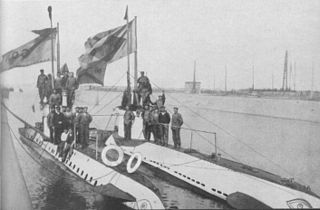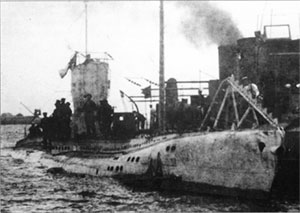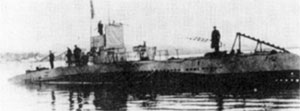Related Research Articles

Naval warfare in the Mediterranean during World War I took place between the naval forces of the Entente and the Central Powers in the Mediterranean Sea between 1914 and 1918.

The Type UB I submarine was a class of small coastal submarines (U-boats) built in Germany at the beginning of the First World War. Twenty boats were constructed, most of which went into service with the German Imperial Navy Boats of this design were also operated by the Austro-Hungarian Navy and the Bulgarian Navy. In the Austro-Hungarian Navy, it was called the U-10 class.
The Austro-Hungarian U-boat fleet was created in the decade prior to the First World War. They were built to a variety of designs, many under licence from Germany. They served throughout the war against Italian, French and British shipping in the Mediterranean Sea with some success, losing eight of the twenty eight boats in service in return. They were reinforced by the Imperial German Navy’s Pola Flotilla, mainly comprising coastal U-boats transported by rail from Germany's northern shipyards to the Austrian ports on the Adriatic Sea. Following the end of the war in 1918, all Austrian submarines were surrendered to the Entente powers, who disposed of them individually. As both Austria and Hungary became landlocked in the aftermath of the war, no Austrian or Hungarian submarines have been commissioned since.

The Adriatic Campaign of World War I was a naval campaign fought between the Central Powers and the Mediterranean squadrons of Great Britain, France, the Kingdom of Italy, Australia, and the United States.

SM UB-46 was a Type UB II submarine or U-boat for the German Imperial Navy during World War I. UB-46 operated in the Mediterranean and the Black Seas, and was sunk by a mine in December 1916.

The Mediterranean U-boat Campaign in the Mediterranean Sea was fought by Austria-Hungary and German Empire against the Allies during World War I. It was characterised by the ability of the Central Powers to raid with near impunity during the first years of the war, causing substantial shipping losses, until the introduction of the convoy system allowed the Allies to drastically cut their losses from 1917 on.

The U-27 class was a class of eight submarines or U-boats built for and operated by the Austro-Hungarian Navy during World War I. The class was based upon the German Type UB II design of the German Imperial Navy and was constructed under license in Austria-Hungary.
SM U-41 or U-XLI was a U-27 class U-boat or submarine for the Austro-Hungarian Navy. U-41, built by the Austrian firm of Cantiere Navale Triestino (CNT) at the Pola Navy Yard, was launched in November 1917. When she was commissioned in February 1918, she became the last boat of her class to enter service. She was also the last domestically constructed Austro-Hungarian U-boat to enter service.
SM U-29 or U-XXIX was a U-27 class U-boat or submarine for the Austro-Hungarian Navy. U-29, built by the Hungarian firm of Ganz Danubius at Fiume, was launched in October 1916 and commissioned in January 1917.
SM U-31 or U-XXXI was a U-27 class U-boat or submarine for the Austro-Hungarian Navy. U-31, built by the Hungarian firm of Ganz Danubius at Fiume, was launched in March 1917 and commissioned in April.
SM UB-47 was a Type UB II submarine or U-boat for the German Imperial Navy during World War I. UB-47 was sold to the Austro-Hungarian Navy during the war. In Austro-Hungarian service the B was dropped from her name and she was known as SM U-47 or U-XLVII as a member of the Austro-Hungarian U-43 class.

SM UB-43 was a Type UB II submarine or U-boat for the German Imperial Navy during World War I. UB-43 was sold to the Austro-Hungarian Navy during the war. In Austro-Hungarian service the B was dropped from her name and she was known as SM U-43 or U-XLIII as the lead boat of the Austro-Hungarian U-43 class.

SM UB-45 was a Type UB II submarine or U-boat built for and operated by the German Imperial Navy during World War I. UB-45 operated in the Mediterranean and the Black Seas, and was sunk by a mine in November 1916.
SM UB-44 was a Type UB II submarine or U-boat for the German Imperial Navy during World War I. UB-44 operated in the Mediterranean and disappeared in August 1916.

SM UB-42 was a Type UB II submarine or U-boat for the German Imperial Navy during World War I. UB-42 operated in the Mediterranean and the Black Seas during the war. She was broken up at Malta in 1920.

SM UB-3 was a German Type UB I submarine or U-boat in the German Imperial Navy during World War I. She disappeared on her first patrol in May 1915, and was the first of her class to be lost.

The U-boat campaign from 1914 to 1918 was the World War I naval campaign fought by German U-boats against the trade routes of the Allies. It took place largely in the seas around the British Isles and in the Mediterranean. The German Empire relied on imports for food and domestic food production and the United Kingdom relied heavily on imports to feed its population, and both required raw materials to supply their war industry; the powers aimed, therefore, to blockade one another. The British had the Royal Navy which was superior in numbers and could operate on most of the world's oceans because of the British Empire, whereas the Imperial German Navy surface fleet was mainly restricted to the German Bight, and used commerce raiders and submarine warfare to operate elsewhere.
The Constantinople Flotilla was an Imperial German Navy formation set up during World War I to execute the U-boat campaign against Allied shipping in the Mediterranean and the Black Sea in support of Germany's ally, the Ottoman Empire. Despite its official name, the U-Boote der Mittelmeerdivision in Konstantinopel, it saw little service in the Mediterranean, operating mostly against Russian shipping in the Black Sea.

The SM UB-48 was a German Type UB III submarine or U-boat in the German Imperial Navy during World War I. It was commissioned into the German Imperial Navy on 11 June 1917 as SM UB-48.
SM UB-49 was a German Type UB III submarine or U-boat in the German Imperial Navy during World War I. She was commissioned into the German Imperial Navy on 28 June 1917 as SM UB-49.
References
- VE Tarrant The U-Boat offensive 1914-1945 (1989) ISBN 0-85368-928-8